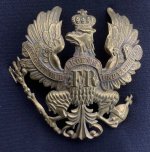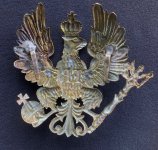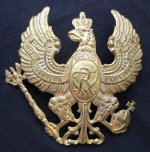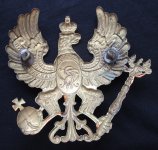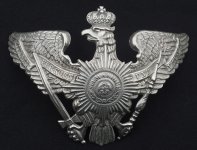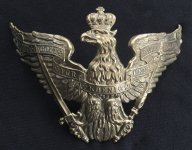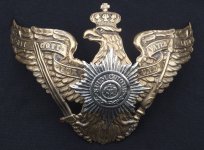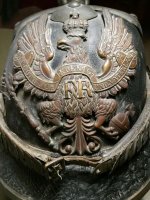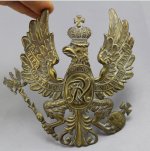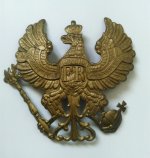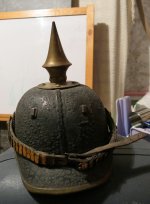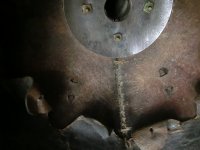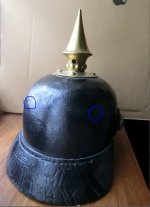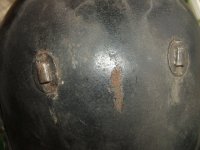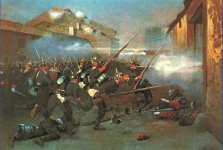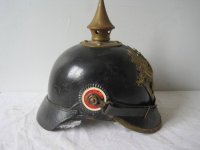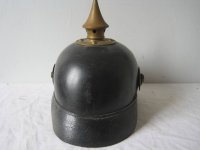SkipperJohn
Well-known member
There seems to be some confusion on Pickelhauben issued in 1860. There are differing opinions on how these helmets were outfitted and how units had these issued. Though the helmets appear much the same externally the Wappen plates and Kokarden do not seem to conform to any standard. Many of the reference books written about Imperial German Headdress begin their research in 1870-71, thereby passing up these earlier models. In order to better understand the Model 1860 Pickelhaube we need to look at a bit of history, and then, like any detective, we need to follow the money. The production methods at the time could not possibly keep up with demand, even if there was funding, and this period must have been an absolute nightmare for the Prussian Quartermaster Corps. This study will examine only those Prussian helmets utilizing the line eagle. Garde Korps, Grenadier, and officer helmets are not considered.
Frederick William IV was the oldest son of Frederick William III of Prussia and he reigned as King of Prussia from 1840 to 1861.

He was referred to as the “Romanticist on the Throne” who was more interested in the arts and architecture than in military affairs and politics. He served with the Prussian Army in the Wars of Liberation against Napoleon Bonaparte in 1814 but was a somewhat disinterested soldier. He was enamored with the middle ages and is most well known for the buildings he constructed in Berlin and Potsdam. He rejected the title of Emperor of the Germans offered by the Parliament in 1849 as being “not the Parliaments to give”. He suffered a stroke in 1857 and was left incapacitated until his death in 1861. His brother William I served as regent from 1858 until the king ‘s death in 1861.
Wilhelm I was the king of Prussia from 1861 until 1888 and served as the first German Emperor from 1871 until his death.

He was a veteran of the Napoleonic Wars and served in the Prussian Army since the age of twelve when his father appointed him as an officer. He served from 1814 onward. He became regent to his brother, and king, Frederick William IV in 1858, and began making his own changes to the German Confederation. Working with his appointed chancellor and Minister President Otto von Bismarck he succeeded in the unification of Germany. Wilhelm inherited a conflict between Frederick William and the liberal Landtag (Parliament). In 1862 the Landtag refused an increase in the military budget needed to pay for the already implemented (1860) reform of the army. This involved raising the peacetime army from 150,000 to 200,000 men and boosting the annual number of new recruits from 40,000 to 63,000. However, the truly controversial part was the plan to keep the length of military service at three years (raised in 1856 from two years). When his request was refused, Wilhelm first considered abdicating, but his son, the Crown Prince, advised strongly against it. The saber rattling of Napoleon III in France and his appointment as Emperor refreshed the extreme dislike of the French in Wilhelm I. The Crimean War and the Franco-Austrian War also contributed to his dedication to the reform of the Prussian military. The final insult occurred when Napoleon III reinstated the Imperial Crest for French Military troops. Wilhelm appointed Otto von Bismarck to the office of Minister President in order to force through the proposals. According to the Prussian constitution, the Minister President was responsible solely to the king, not to the Landtag. Bismarck was a conservative Prussian Junker and a loyal friend of the king. It was Bismarck who effectively directed politics, domestic as well as foreign.
The reformation of the military implemented by Wilhelm I in 1860, while he was acting as regent, added 32 new infantry regiments to the existing Prussian Army. Each of these regiments required rifles, pistols, swords, uniforms, belts, ammo pouches, field packs, canteens, bayonets, boots, and, of course, helmets. Pickelhauben were probably not the priority when considering outfitting these regiments. All this equipment was required, but the Landtag refused to pay for it. The Prussian Army was left to its own devices to conform to the new standards.
The Pickelhaube changed in several ways with the new 1860 directives. The bandeaux “MIT GOTT FÜR KOENIG UND VATERLAND” was to be added to the Wappen above the FR or FWR cypher. The Kokarde was reduced to 57mm and the helmet was reduced in size. The reduction in height made it necessary to introduce a 120mm Wappen as the 125mm Wappen was too large. These changes could not occur overnight, and with no money to pay for the changes, many variations exist. Four common variations of the Prussian Wappen can be found on Model 1860 Pickelhauben.
The first type, and likely the most expedient, was to use the existing 1842 Wappen and solder a bandeau on it so that it would conform to the new regulations. This is an example of one such Wappen:

Holes were drilled in the plate to ensure that the bandeau was well attached.


This Wappen is on a Model 1853/60 Kurassier:


More on this helmet can be found here: https://www.pickelhaubes.com/bb/viewtopic.php?f=41&t=11811
The second type of Wappen still utilized the Model 1842, but now the bandeau was part of the stamping and not a separate soldered on part:

This Wappen is on a Model 1860 Fusilier helmet:

More on this helmet can be found here: https://www.pickelhaubes.com/bb/viewtopic.php?f=9&t=12354
The third type, commonly referred to as the “proper” type for 1860, is the straight tail feather type:

This type measured 125mm from the top of the crown to the bottom of the tail feathers.
This Wappen is on a Model 1860 Fußartillery helmet:

More on this helmet can be found here: https://www.pickelhaubes.com/bb/viewtopic.php?f=52&t=11280
The fourth type, which meets all the directives for 1860, is the straight tail feather type but now reduced in size to 120mm:

This Wappen is on a Model 1860 Infantry:

Not only were Wappens repurposed for the expansion of the army, Kokarden were also reused. Each of the above helmets has a different Kokarde, from an earlier wool Kokarde (1856 and earlier),

a 75mm stamped Kokarde (1857),

a stamped 68mm Kokarde (unknown which years this was used and on which applications),

and the correct 57mm stamped Kokarde.

Earlier Pickelhauben were cut down to conform to the new height standards as outlined in the directives, but this didn’t happen in a uniform fashion either. Each of the leather helmets shown above varies in height ranging in a difference of up to 1.25 inches.
It may be noted that the subsequent Pickelhaube, Model 1867, suffered many of the same growing pains as the Model 1860.
Model 1860 helmets were retained in service after 1867 since production could not possibly produce enough Model 1867 helmets to meet demand and they were used by the Prussian Army as well as other contingents. Many were updated with new parts, as needed, and reissued. Here is a Bremen example:

More on this helmet can be seen here: https://www.pickelhaubes.com/bb/viewtopic.php?f=9&t=10529
This was not the end of the Model 1860. Many were re-purposed, outfitted with a Garde Wappen, and put into service for the Landgendarmerie. Many Model 1867's were used by the Landgendarmerie as well. Some continued in service until the 1880's. I have seen no evidence that the Model 1860 or 1867 saw service in World War I.
When Wilhelm I became the first German Emperor in 1871 the money required to outfit the army was no longer a contested issue. The newly unified Germany became the predominant power in Europe and armies the world over emulated the Prussian Army, even the U.S.
John
Frederick William IV was the oldest son of Frederick William III of Prussia and he reigned as King of Prussia from 1840 to 1861.

He was referred to as the “Romanticist on the Throne” who was more interested in the arts and architecture than in military affairs and politics. He served with the Prussian Army in the Wars of Liberation against Napoleon Bonaparte in 1814 but was a somewhat disinterested soldier. He was enamored with the middle ages and is most well known for the buildings he constructed in Berlin and Potsdam. He rejected the title of Emperor of the Germans offered by the Parliament in 1849 as being “not the Parliaments to give”. He suffered a stroke in 1857 and was left incapacitated until his death in 1861. His brother William I served as regent from 1858 until the king ‘s death in 1861.
Wilhelm I was the king of Prussia from 1861 until 1888 and served as the first German Emperor from 1871 until his death.

He was a veteran of the Napoleonic Wars and served in the Prussian Army since the age of twelve when his father appointed him as an officer. He served from 1814 onward. He became regent to his brother, and king, Frederick William IV in 1858, and began making his own changes to the German Confederation. Working with his appointed chancellor and Minister President Otto von Bismarck he succeeded in the unification of Germany. Wilhelm inherited a conflict between Frederick William and the liberal Landtag (Parliament). In 1862 the Landtag refused an increase in the military budget needed to pay for the already implemented (1860) reform of the army. This involved raising the peacetime army from 150,000 to 200,000 men and boosting the annual number of new recruits from 40,000 to 63,000. However, the truly controversial part was the plan to keep the length of military service at three years (raised in 1856 from two years). When his request was refused, Wilhelm first considered abdicating, but his son, the Crown Prince, advised strongly against it. The saber rattling of Napoleon III in France and his appointment as Emperor refreshed the extreme dislike of the French in Wilhelm I. The Crimean War and the Franco-Austrian War also contributed to his dedication to the reform of the Prussian military. The final insult occurred when Napoleon III reinstated the Imperial Crest for French Military troops. Wilhelm appointed Otto von Bismarck to the office of Minister President in order to force through the proposals. According to the Prussian constitution, the Minister President was responsible solely to the king, not to the Landtag. Bismarck was a conservative Prussian Junker and a loyal friend of the king. It was Bismarck who effectively directed politics, domestic as well as foreign.
The reformation of the military implemented by Wilhelm I in 1860, while he was acting as regent, added 32 new infantry regiments to the existing Prussian Army. Each of these regiments required rifles, pistols, swords, uniforms, belts, ammo pouches, field packs, canteens, bayonets, boots, and, of course, helmets. Pickelhauben were probably not the priority when considering outfitting these regiments. All this equipment was required, but the Landtag refused to pay for it. The Prussian Army was left to its own devices to conform to the new standards.
The Pickelhaube changed in several ways with the new 1860 directives. The bandeaux “MIT GOTT FÜR KOENIG UND VATERLAND” was to be added to the Wappen above the FR or FWR cypher. The Kokarde was reduced to 57mm and the helmet was reduced in size. The reduction in height made it necessary to introduce a 120mm Wappen as the 125mm Wappen was too large. These changes could not occur overnight, and with no money to pay for the changes, many variations exist. Four common variations of the Prussian Wappen can be found on Model 1860 Pickelhauben.
The first type, and likely the most expedient, was to use the existing 1842 Wappen and solder a bandeau on it so that it would conform to the new regulations. This is an example of one such Wappen:

Holes were drilled in the plate to ensure that the bandeau was well attached.


This Wappen is on a Model 1853/60 Kurassier:


More on this helmet can be found here: https://www.pickelhaubes.com/bb/viewtopic.php?f=41&t=11811
The second type of Wappen still utilized the Model 1842, but now the bandeau was part of the stamping and not a separate soldered on part:

This Wappen is on a Model 1860 Fusilier helmet:

More on this helmet can be found here: https://www.pickelhaubes.com/bb/viewtopic.php?f=9&t=12354
The third type, commonly referred to as the “proper” type for 1860, is the straight tail feather type:

This type measured 125mm from the top of the crown to the bottom of the tail feathers.
This Wappen is on a Model 1860 Fußartillery helmet:

More on this helmet can be found here: https://www.pickelhaubes.com/bb/viewtopic.php?f=52&t=11280
The fourth type, which meets all the directives for 1860, is the straight tail feather type but now reduced in size to 120mm:

This Wappen is on a Model 1860 Infantry:

Not only were Wappens repurposed for the expansion of the army, Kokarden were also reused. Each of the above helmets has a different Kokarde, from an earlier wool Kokarde (1856 and earlier),

a 75mm stamped Kokarde (1857),

a stamped 68mm Kokarde (unknown which years this was used and on which applications),

and the correct 57mm stamped Kokarde.

Earlier Pickelhauben were cut down to conform to the new height standards as outlined in the directives, but this didn’t happen in a uniform fashion either. Each of the leather helmets shown above varies in height ranging in a difference of up to 1.25 inches.
It may be noted that the subsequent Pickelhaube, Model 1867, suffered many of the same growing pains as the Model 1860.
Model 1860 helmets were retained in service after 1867 since production could not possibly produce enough Model 1867 helmets to meet demand and they were used by the Prussian Army as well as other contingents. Many were updated with new parts, as needed, and reissued. Here is a Bremen example:

More on this helmet can be seen here: https://www.pickelhaubes.com/bb/viewtopic.php?f=9&t=10529
This was not the end of the Model 1860. Many were re-purposed, outfitted with a Garde Wappen, and put into service for the Landgendarmerie. Many Model 1867's were used by the Landgendarmerie as well. Some continued in service until the 1880's. I have seen no evidence that the Model 1860 or 1867 saw service in World War I.
When Wilhelm I became the first German Emperor in 1871 the money required to outfit the army was no longer a contested issue. The newly unified Germany became the predominant power in Europe and armies the world over emulated the Prussian Army, even the U.S.
John

